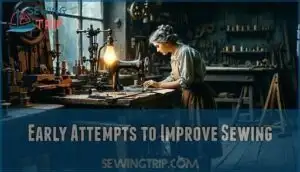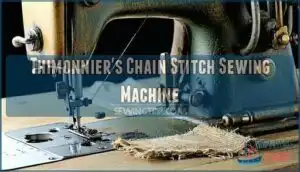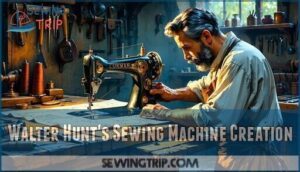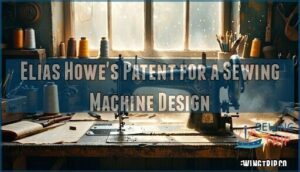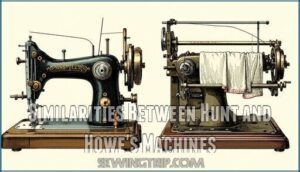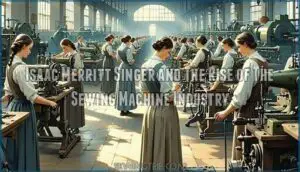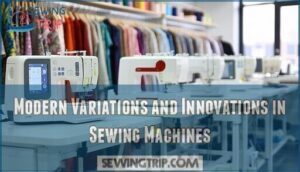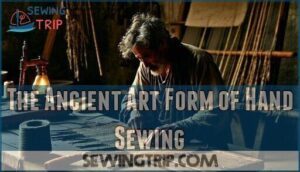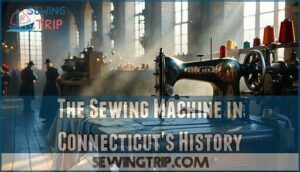This site is supported by our readers. We may earn a commission, at no cost to you, if you purchase through links.
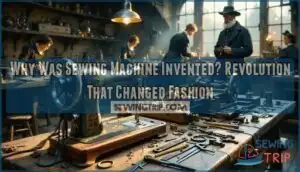
You’ve got growing populations, booming cities, and everyone needs clothes – but stitching everything by hand was painfully slow and expensive.
Manufacturers were stuck in a bottleneck that threatened their entire business model.
Early inventors like Thomas Saint and Barthélemy Thimonnier recognized this crisis and raced to mechanize the process.
Their breakthrough wasn’t just about speed – it was about survival in a rapidly industrializing world where efficiency meant everything.
The invention sparked fierce competition, patent battles, and even riots from threatened tailors who saw their livelihoods disappearing overnight.
What started as a simple solution to production delays became the catalyst that transformed fashion forever, leading to a new era of industrialization.
Table Of Contents
- Key Takeaways
- The Birth of Mechanical Sewing
- Early Attempts to Improve Sewing
- Barthélemy Thimonnier and The First Functional Machine
- Walter Hunt, Elias Howe, and The Evolution of Sewing Machines
- Isaac Merritt Singer and The Rise of The Sewing Machine Industry
- Impact on Clothing Manufacturing and The Fashion Industry
- Modern Variations and Innovations in Sewing Machines
- The Ancient Art Form of Hand Sewing
- The Sewing Machine in Connecticut’s History
- Frequently Asked Questions (FAQs)
- Conclusion
Key Takeaways
- You needed faster production to meet exploding demand – Hand-sewing took 14 hours per shirt while growing populations and booming cities created massive clothing bottlenecks that threatened entire business models
- Economic survival drove desperate innovation – Manufacturers faced a crisis where painfully slow hand-stitching couldn’t keep pace with industrialization, forcing inventors like Saint and Thimonnier to race toward mechanization
- Early inventors endured violent resistance and financial ruin – Angry tailors literally burned down factories while pioneers like Howe pawned watches to fund prototypes, facing years of patent battles and technical failures
- The machine democratized fashion forever – What started as a production solution transformed clothing from luxury to necessity, making stylish garments accessible to ordinary people and spawning today’s entire fashion industry
The Birth of Mechanical Sewing
Imagine this: for thousands of years, every shirt, dress, and pair of pants required hours of painstaking hand-stitching.
Picture seamstresses squinting by candlelight, fingers raw from endless needlework—until machines changed everything forever.
The birth of mechanical sewing didn’t happen overnight—it took decades of trial and error before inventors cracked the code.
Early mechanisms faced major design challenges.
Charles Weisenthal’s 1755 needle innovations couldn’t form proper stitches, while Thomas Saint’s 1790 leather machine existed only on paper.
The real breakthrough came with stitch formation breakthroughs—Barthélemy Thimonnier’s 1830 chain stitch machine finally worked, though angry tailors burned his factory down.
These automation origins weren’t just about convenience.
The Industrial Revolution demanded faster textile production, and sewing machine invention became essential.
Each pioneer built on previous needle innovations, gradually solving design challenges that plagued early mechanisms.
From Thimonnier’s functional prototype to Elias Howe’s lockstitch patent, sewing machine history shows how persistence paid off.
Understanding the sewing machine purpose reveals why this revolution changed everything—transforming clothing from luxury to necessity.
Early Attempts to Improve Sewing
You’ll discover that the early 1800s brought a wave of ambitious inventors who recognized the massive potential for mechanizing sewing, though their initial attempts often fell short of practical success.
These pioneering efforts laid the groundwork for the revolutionary machines that would eventually transform how clothing was made, even when their creators faced significant technical and commercial challenges, making their contributions to the field truly pioneering.
Thomas Saint’s Leather Sewing Machine
Thomas Saint’s leather-focused machine design broke ground in 1790 Patent history, introducing revolutionary mechanization concepts decades ahead of their time.
His Saints Design featured a crank mechanism that powered an innovative chain-stitch system specifically engineered for leather application on boots, saddles, and ship sails.
Though never commercially built during his lifetime, Saint’s engineering blueprint included sophisticated elements like tensioning systems and feed mechanisms that would later influence successful sewing machine invention.
- You’d marvel at how Saint’s forgotten patent lay dormant for 80 years before rediscovery
- His chain-stitch method tackled thick leather that would challenge even modern machines
- The intricate crank mechanism synchronized multiple moving parts with remarkable precision
Impact Assessment reveals Saint’s foundational contribution to early sewing machines and Thomas Saint sewing machine history, establishing mechanical principles that future inventors would unknowingly echo in their breakthrough designs.
Josef Madersperger’s Sewing Machine Patent
Despite facing significant market challenges, Josef Madersperger wasn’t deterred by earlier failures.
In 1814, this Austrian tailor secured a sewing machine patent after years of tinkering with Maderspergers Designs. His invention promised to revolutionize textile work, but design flaws plagued his multiple prototypes.
The patent details revealed ambitious mechanical concepts that couldn’t match the practical demands of commercial sewing. Madersperger’s machines struggled with thread tension and fabric handling, making them unreliable for everyday use.
Though his sewing machine patents never achieved commercial success, Maderspergers Legacy inspired future sewing machine inventors. His persistent efforts proved that automated stitching was possible, even if perfection remained elusive.
Balthasar Krems’ Automatic Cap-Sewing Machine
Around 1810, German inventor Balthasar Krems created an automatic cap-sewing machine that broke new ground in textile automation.
While Krems’ machine never achieved commercial success, his Krems Innovation introduced revolutionary features that shaped future sewing machine invention.
His Cap Automation system used a pioneering needle design with the eye at the point—now standard in all sewing machines.
The Machine Functionality focused on circular stitching, perfect for Sewing Caps production.
Though mechanical failures plagued his prototype, preventing mass adoption, Krems’ work during the sewing machine industrial revolution established fundamental foundations.
5 Ways Krems Changed Sewing Forever:
- Revolutionary needle design – Eye-pointed needles became industry standard
- Circular stitching breakthrough – Enabled automated cap production methods
- Chain stitch innovation – Single-thread technique influenced later inventors
- Foot-operated mechanism – Freed hands for fabric manipulation
- Industrial inspiration – Proved mechanized sewing was possible
The sewing machine benefits from Krems’ early experiments remain visible today.
His Krems Legacy lives on through every modern machine, proving that even "failed" inventions can spark revolutionary change in sewing machine cap production and beyond.
John Adams Doge and John Knowles’ American Sewing Machine
While Krems struggled with functionality, John Adams Doge and John Knowles created America’s first sewing machine in 1818.
Their Doge-Knowles Machine featured innovative up-and-down needle movement, representing significant American Innovation in automated stitching.
Despite the Fragile Design proving too delicate for practical use, their 1818 Sewing attempt marked pivotal progress in sewing machine invention.
These sewing machine pioneers faced Early Challenges with commercialization, yet their lockstitch mechanism inspired future inventors.
Though sewing machine commercialization remained elusive, their work laid groundwork for the coming patent disputes and lawsuits that would define the industry’s evolution.
Barthélemy Thimonnier and The First Functional Machine
You might think Barthélemy Thimonnier was just another ambitious inventor, but in 1830 he actually created the first functional sewing machine that could produce usable garments.
His chain stitch machine proved so effective that he opened the world’s first mechanized clothing factory, only to watch angry tailors burn it down when they realized machines threatened their livelihoods.
Thimonnier’s Chain Stitch Sewing Machine
Barthlemy Thimonnier’s revolutionary chain stitch sewing machine in 1830 marked sewing machine history’s first functional breakthrough. You’ll find his innovation fascinating – he created Chain Stitch Mechanics that actually worked, unlike previous failed attempts at sewing machine development.
His design used a hooked needle for creating the chain stitch.
His machine’s capabilities were impressive despite Machines Imperfections:
- Production Speed increased dramatically over hand-sewing methods
- Thread Consumption remained efficient through his chain stitch design
- Stitch Durability proved adequate for basic garment construction
- Sewing machine innovations included practical needle and thread mechanisms
Thimonnier established Paris’s first mechanized sewing factory with eighty machines, demonstrating industrial potential.
His chain stitch technique became foundational for future sewing machine development, proving mechanical stitching could revolutionize textile production despite early technical limitations.
Rioting Tailors and Factory Fire
Thimonnier’s success sparked Thimonniers Troubles when his factory employment threatened traditional craftsmen.
On January 20, 1831, approximately 200 tailors launched a Tailor Uprising, storming his Paris workshop.
This Labor Unrest mirrored Luddite Actions across Europe during industrial revolution sewing automation.
The mob achieved complete Factory Destruction, burning all 80 machines while Barthlemy Thimonnier barely escaped.
This violent social change highlighted tensions surrounding textile industry automation progress.
Walter Hunt, Elias Howe, and The Evolution of Sewing Machines
You’ll discover how two American inventors independently developed similar sewing machines that would reshape textile production forever.
Walter Hunt’s ingenious design in the 1830s and Elias Howe’s patented lockstitch machine in 1846 sparked legal battles that ultimately accelerated innovation in the industry, with lockstitch machine being a crucial development.
Walter Hunt’s Sewing Machine Creation
Innovation sometimes thrives in unexpected hands.
Walter Hunt’s revolutionary sewing machine design from 1834 featured groundbreaking sewing machine technology that would reshape manufacturing forever.
His eye-pointed needle and double thread system created the world’s first practical lockstitch mechanism, making him an unrecognized inventor whose Hunts Innovation laid the foundation for modern sewing machine mechanical needle designs.
Thimonnier’s chain stitch improved garment production.
Unfortunately, Hunt’s lost patent decision would haunt the industry:
- He feared his sewing machine invention would eliminate seamstress jobs
- Financial constraints prevented proper patent filing and marketing
- His breakthrough sewing machine design concepts were later adopted by others
Hunt’s sewing innovation demonstrated remarkable foresight in mechanical engineering, yet his ethical concerns about unemployment overshadowed commercial opportunities.
Elias Howe’s Patent for a Sewing Machine Design
The pivotal moment arrived when Elias Howe secured his groundbreaking patent in 1846.
His Elias Howe invention featured a revolutionary lockstitch mechanism that created stronger, more durable seams than previous attempts.
The sewing machine design included an eye-pointed needle working with a shuttle system, dramatically improving stitch quality.
However, patent disputes immediately erupted as competitors claimed similar innovations.
Despite the commercial impact potential, Howe’s struggles were just beginning—he faced financial hardship and legal battles that would define the early sewing machine industry for years to come, marked by patent disputes, financial hardship, and legal battles.
Similarities Between Hunt and Howe’s Machines
When you examine Hunt’s and Howe’s sewing machine designs side by side, you’ll discover remarkable parallels that emerged independently. Both inventors revolutionized Seam creation through nearly identical innovations, proving that great minds often think alike during periods of technological advancement.
Their shared breakthrough centered on the Eye-pointed needle design, which positioned the eye near the needle’s tip rather than at the base. This seemingly simple change enabled the Lockstitch mechanism that would define modern sewing machine evolution.
Here’s what made their machines so similar:
- Eye-pointed needle piercing fabric from above
- Shuttle system carrying a second Thread source below
- Reciprocating needle movement creating consistent stitches
- Automatic Fabric feeding mechanism advancing material
- Lockstitch formation interlocking threads for strength
These sewing machine early innovations emerged from the same industrial pressures facing 1840s textile manufacturers. Both inventors understood that efficient Seam creation required abandoning traditional hand-sewing methods. Their parallel thinking demonstrates how the Elias Howe invention period sparked widespread experimentation in sewing machine designs, setting the stage for future patent disputes over similar mechanisms.
Howe’s Struggles and Legal Battles
Despite inventing the lockstitch machine, Elias Howe Jr faced devastating financial hardships and lengthy sewing machine patent battles.
Patent infringement cases drained his resources while competitors profited from his innovation.
Howe’s perseverance through these intellectual property disputes and sewing machine lawsuits eventually secured his lockstitch legacy, though years of court cases left him nearly broke before justice prevailed, showcasing his determination in the face of financial hardships.
Isaac Merritt Singer and The Rise of The Sewing Machine Industry
While Walter Hunt and Elias Howe laid the groundwork for practical sewing machines, you’ll discover that Isaac Singer transformed these inventions into a thriving industry through smart business practices and aggressive marketing.
Singer’s improvements to existing designs, combined with his formation of the first patent pool and profit-sharing agreements, turned the sewing machine from a workshop curiosity into America’s first mass-produced household appliance, leveraging aggressive marketing to fuel its success.
Singer’s Widely Copied Sewing Machine
Isaac Singer’s revolutionary machine became the gold standard that competitors couldn’t resist copying.
Building on Hunt and Howe’s breakthroughs, Singer’s innovations transformed sewing from tedious handwork into efficient production.
His Singer sewing machine featured groundbreaking design elements that set new industry standards:
- Sturdy iron bedplate and arm providing rock-solid stability during operation
- Vertical pressure foot ensuring smooth, consistent fabric feeding
- Automatic tension release system activating when raising the needle
- User-friendly foot treadle making operation effortless for workers
Singer’s business acumen matched his engineering prowess, achieving unprecedented market dominance through aggressive sewing machine marketing and strategic patent infringement settlements.
His brand recognition became so powerful that "Singer" practically meant "sewing machine."
This global expansion strategy, combined with profit-sharing agreements with Howe, created the foundation for the modern sewing machine business while establishing lasting sewing machine impact on manufacturing worldwide.
Formation of The First Patent Pool
The notorious "Sewing Machine War" erupted when inventors clashed over patent rights, creating chaos in the industry.
You’d witness endless legal battles draining resources until four key players—Howe, Singer, Wheeler & Wilson, and Grover & Baker—formed America’s first patent pool in 1856.
This groundbreaking Howe-Singer Agreement established licensing agreements that ended sewing machine patent disputes, creating unprecedented market dominance through collaborative patent pooling with lasting legal implications, and resulted in significant industry chaos.
Singer’s Marketing Efforts and Success
Isaac Merritt Singer’s marketing prowess transformed his sewing machine from mechanical invention to household necessity.
His Marketing Strategies revolutionized how you’d encounter consumer products, establishing unprecedented Brand Recognition through aggressive advertising campaigns.
Singer’s Innovation extended beyond machinery into commercial viability:
- Installment payments made expensive machines accessible to average families
- Global Expansion through franchised dealers created worldwide distribution networks
- Mass production techniques reduced costs while maintaining quality standards
This marketing strategy generated remarkable Social Impact, as Singer’s approach democratized sewing technology.
His brand became synonymous with reliable craftsmanship, while his installment payment system pioneered modern consumer financing.
Singer’s innovations built upon Elias Howe’s lockstitch design.
Singer’s combination of superior engineering and savvy promotion established the template for industrial marketing success.
Sharing Profits With Elias Howe
After years of sewing machine patent litigation, Singer’s legal troubles with Howe reached a turning point.
Patent enforcement meant Singer couldn’t avoid paying Howe’s compensation any longer, and their legal agreements transformed former enemies into unlikely business partners.
Singer’s royalties to Howe created a profitable arrangement – each machine sold meant money for both inventors, establishing industry dominance, with sewing machine patent rights generating substantial wealth.
Howe’s sewing machine patent royalties lifted him from poverty to prosperity, proving that persistence through sewing machine legal battles could pay off handsomely, and his determination ultimately led to a life of prosperity, thanks to the substantial wealth generated by the partnership.
Impact on Clothing Manufacturing and The Fashion Industry
You’ll discover how the sewing machine transformed clothing from a luxury craft into mass-produced necessity, cutting production time from 14 hours to just over an hour for a single garment.
This mechanical revolution didn’t just speed up manufacturing—it reshaped entire industries, created new job markets, and made fashionable clothing accessible to ordinary people for the first time in history.
Revolutionizing Garment Production
Before machines transformed garment production, you’d wait weeks for a single dress.
The sewing machine revolution changed everything, releasing mass production that made affordable clothing accessible to ordinary families.
- Mass Production enabled factories to create thousands of garments daily
- Factory Efficiency reduced production time from days to hours
- Affordable Clothing transformed fashion from luxury to necessity
- Garment Durability improved through consistent machine stitching
This textile manufacturing breakthrough during the industrial revolution democratized fashion completely.
Challenges Faced by Early Inventors
Despite their groundbreaking innovations, early sewing machine inventors faced crushing Patent Disputes and Technical Difficulties that nearly destroyed their dreams.
You’d find Barthélemy Thimonnier watching angry tailors burn his factory down, fearing job losses from his revolutionary machine.
Meanwhile, Elias Howe pawned his watch just to afford prototype materials, battling years of Market Acceptance rejection and Design Limitations that kept investors away.
These pioneers endured Funding Issues so severe that Howe sailed to England seeking support, only to face sewing machine patent controversies and mechanical innovations theft.
Isaac Singer’s marketing prowess helped popularize sewing machines in middle-class homes.
Their persistence through sewing machine challenges ultimately transformed fashion forever.
Enduring Legacy of The Sewing Machine
Looking at the technological advancement through the lens of history, you’ll discover the sewing machine’s legacy spans far beyond simple stitching.
Today’s innovations continue building upon this foundation:
- Home Sewing democratized fashion creation, empowering personal Artistic Expression
- Global Industry worth billions stems from this single technological breakthrough
- Future Innovations in smart textiles trace back to mechanical precision pioneered centuries ago
The sewing machine legacy represents humanity’s ability to transform labor into art, creating both economic impact and social impact that resonates through Fashion Influence and historical significance today.
Modern Variations and Innovations in Sewing Machines
Today’s sewing machines have evolved far beyond Isaac Singer’s original design, offering specialized features you’d never find in those early 1850s models.
You’ll discover computerized machines that create intricate embroidery patterns, sergers that finish edges like a pro, and portable units that fit in your backpack for on-the-go repairs.
Different Types of Sewing Machines
Today’s sewing machines come in specialized varieties that tackle different projects with precision.
Industrial machines handle heavy-duty manufacturing, while home machines offer everyday versatility for repairs and crafts.
Many factories rely on durable sewing equipment for their output.
| Machine Type | Primary Use |
|---|---|
| Industrial Machines | Heavy fabrics, mass production |
| Embroidery Machines | Decorative stitching, logos |
| Serger Machines | Seam finishing, stretchy fabrics |
| Quilting Machines | Large quilts, intricate patterns |
Whether you’re running a factory or stitching at your kitchen table, specialized sewing machine types deliver targeted performance that hand-sewing simply can’t match.
China as The Largest Producer
Since China’s manufacturing revolution began decades ago, you’ve witnessed an incredible transformation in sewing machine production.
Today, China dominates global sewing machine manufacturing capabilities, producing 6.4 million industrial units in 2024 alone.
This market dominance stems from concentrated manufacturing hubs in Zhejiang, Jiangsu, and Guangdong provinces.
Export statistics reveal China shipped $4.69 billion worth of textile machinery to 202 countries, with Asian manufacturers benefiting most.
Future trends point toward AI-powered machines and smart manufacturing systems, reinforcing China’s leadership in sewing machine globalization, with a focus on global markets.
Evolution of Sewing Machine Designs
You’ll find that sewing machine design evolution reflects humanity’s relentless pursuit of efficiency.
Early Needle Mechanisms shifted from side-to-side movement to vertical precision by the 1850s. Stitch Formation improved dramatically with rotating hook designs, enabling faster, more reliable stitching.
The 1860s brought treadle machines, making home use feasible through improved Material Handling systems. Automation Advances accelerated in the 1870s when electric Power Sources replaced manual operation.
Modern sewing machine mechanical advancements include programmable zigzag stitching from the 1950s, while today’s sewing machine technological evolution incorporates computerized controls. Many users now prefer advanced sewing technology for their projects.
These sewing machine design improvements transformed both industrial production and domestic crafting, proving that sewing machine functional design continues adapting to meet changing needs.
The Ancient Art Form of Hand Sewing
Before sewing machines revolutionized textile production, hand stitching represented humanity’s primary method for creating clothing and fabrics.
This ancient craft stretches back over 20,000 years, with archaeological evidence revealing sophisticated needlework history across civilizations.
Ancient embroidery and textile origins tell fascinating stories of human creativity.
Early artisans developed intricate seam techniques that still influence modern needlework.
Chinese craftspeople perfected decorative stitching during the Neolithic period, while other cultures contributed unique manual stitching methods.
Here are four remarkable aspects of ancient sewing traditions:
- Bone needles from 40,000 years ago show our ancestors’ ingenuity
- Silk embroidery in China dates back 4,000 years
- Viking textiles featured complex patterns requiring exceptional skill
- Medieval tapestries took years to complete by hand
Ancient textiles required patience and expertise that machines couldn’t replicate.
Each stitch carried personal meaning, making garments treasured possessions rather than disposable items.
The quality of these items depended heavily on the available needle selection.
Understanding these sewing machine ancient origins helps us appreciate why mechanical innovation became necessary as societies demanded faster production methods.
The Sewing Machine in Connecticut’s History
Connecticut’s innovative spirit blazed brightest during the Industrial Revolution, when three groundbreaking moments shaped manufacturing history:
- 1790 – Oliver Evans invents the high-pressure steam engine to power automatic flour mills in Delaware
- 1813 – Thomas Blanchard of Middlebury, Connecticut, patents a metal lathe enabling mass production of interchangeable parts
- 1846 – Elias Howe receives the first United States patent for a sewing machine after moving his business to Connecticut
Howe’s machine used a needle with an eye at the point and a shuttle carrying a second thread. Connecticut inventors didn’t just tinker—they revolutionized entire industries. Waterbury manufacturing became synonymous with precision engineering, while local factories churned out sewing machines for Civil War production needs.
The economic impact was staggering. Connecticut history shows how sewing machine advancements transformed the state into America’s innovation hub. These sewing machine Connecticut roots cemented the state’s reputation for iconic American inventions that changed how people lived and worked.
Frequently Asked Questions (FAQs)
Why did they invent sewing machines?
Inventors created sewing machines because hand-sewing was painfully slow – you’d spend 14 hours making one shirt! They needed faster production to meet growing demand during industrialization.
Why did Isaac Singer invent the sewing machine?
Actually, Isaac Singer didn’t invent the sewing machine – he improved existing designs.
You’ll find he commercialized it brilliantly, adding features like foot pedals and horizontal tables that made machines practical for everyday use and profitable.
What is the main purpose of a sewing machine?
You’ll transform raw fabric into finished garments, home décor, and repairs with speed and precision that hand-sewing simply can’t match, making textile creation accessible and efficient.
What was sewing originally used for?
Originally, you’d use sewing for basic survival needs – repairing torn clothing, mending fabric tears, and creating simple garments by hand to stay warm and protected.
How much did early sewing machines cost?
Early sewing machines carried a hefty price tag – you’d pay around $125 when the average American earned just $500 yearly, making them a significant investment for most families.
What fabrics could early machines handle best?
You’d find early sewing machines worked best with heavier fabrics like leather and canvas, since Thomas Saint designed his 1790 machine specifically for these materials, while lighter fabrics proved challenging.
How fast were the first sewing machines?
Picture a seamstress who’d spent fourteen hours hand-stitching a shirt suddenly completing one in seventy-five minutes.
You’d witness the revolution of early sewing machines averaging 2,000 stitches per minute versus hand-sewing’s mere thirty.
When did electric sewing machines first appear?
Electric sewing machines first appeared in the 1870s, revolutionizing factory production by automating the stitching process.
You’d find these machines dramatically increasing productivity and reducing the manual effort required for large-scale garment manufacturing during this transformative industrial period, with complete concepts like automation and transformative industrial changes being key.
Which countries first adopted sewing machine technology?
Like a thread weaving through history’s fabric, sewing machine technology spread from Britain, the United States, and Canada in the 1840s-1850s.
You’ll find these industrial powerhouses pioneered mechanical stitching during their textile manufacturing boom periods, which is a complete concept that can be understood on its own.
Conclusion
Imagine scrolling through Instagram in 1845—impossible without the sewing machine revolution that birthed mass fashion production.
Understanding why the sewing machine was invented reveals humanity’s relentless drive to solve bottlenecks through innovation.
You’ve witnessed how economic pressure, inventor rivalry, and social upheaval converged to mechanize needle and thread.
The machine didn’t just speed up production—it democratized fashion, making stylish clothing accessible to ordinary people.
Today’s fast fashion industry, designer brands, and even your favorite t-shirt exist because visionary inventors refused to accept hand-sewing’s limitations.

